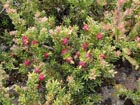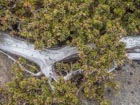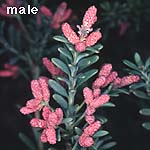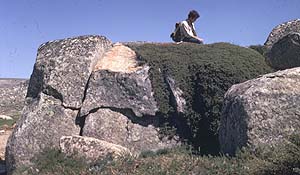
A plant bearing ripe seeds on boulder scree in Lobster Rivulet Forest Reserve, Tasmania [Royal Tasmanian Botanical Gardens, 2017.02.02].

A plant in habitat at Mount Field National Park, Tasmania [C. J. Earle, 2015.02.27].

Stem and foliage of a plant at Mount Field National Park, Tasmania [C. J. Earle, 2015.02.27].

Foliage on a plant near Lake Dobson, Mount Field National Park, Tasmania [©Rick Fencl, 2017.11.24].

Ovulate cone (ANBG [no date]).

Staminate cones (ANBG [no date]).

Plant in habitat (ANBG [no date]).

Podocarpus lawrencei
Hooker 1845
Common names
Alpine plum pine, mountain plum pine (Harden 1990).
Taxonomic notes
Syn: P. alpinus R. Br. ex Hook. f. 1845; P. alpinus R. Br. ex Hook. f. var. lawrencei (Hook. f.) Hook. f.
Description
Shrubs, procumbent to erect, 0.5-1(-4) m tall, usually forming clumps to 4-5 m across. Profusely branched, with whip shoots at the growing tips that end in 1-2 mm diam. globose buds. Leaves crowded, sessile, decurrent, mostly linear-oblong, 4-16 × 2-5 mm, tapering to a slightly twisted base; dark green above, light green with two pale stomatal bands flanking a prominent midrib below. Pollen cones axillary and solitary, or in small clusters of 2-3 (-6) at ends of branchlets; cylindrical, 4-7 × 2-2.5 mm. Seed cones axillary, solitary, sessile or nearly so, receptacles at maturity 5-6 mm long, subglobose, succulent, dark red, each bearing a solitary seed at its distal end, 4.5-5 × 2.5-3 mm including the olive-green epimatium (Harden 1990, Farjon 2010).
Commonly occurs with Diselma archeri, Microcachrys tetragona, and Pherosphaera hookeriana.
Distribution and Ecology
Australia: Tasmania, Victoria, and New South Wales, at elevations of 1100-2030 m, which corresponds to subalpine to alpine areas near the peaks of the highest mountains, where it mostly occupies rocky areas with acidic rock types. Near its lower elevation limit, it can also occur in wet sclerophyll forest with species of Eucalyptus, Acacia, and Telopea, and here is where the largest specimens (up to 4 m tall) can be found. More often, it is seen in subalpine and alpine dwarf scrub and alpine herbaceous grassland. In Tasmania it is often found with three other small, endemic conifers: Diselma archeri, Microcachrys tetragona, and Pherosphaera hookeriana (Farjon 2010). Based on data from 79 collection localities, its climate preferences include a mean annual temperature of 7.8°C, with an average minimum in the coldest month of -2.1°C, and a mean annual precipitation of 1438 mm (Biffin et al. 2011, Table S5); this and Podocarpus nivalis appear to be the most cold-adapted species in the family. Hardy to Zone 7 (cold hardiness limit between -17.7°C and -12.2°C) (Bannister and Neuner 2001).
Remarkable Specimens
Ages up to 460 years are cited without supporting evidence (ANBG [no date]).
Ethnobotany
Although it is potentially a good rock garden plant, and is sometimes so seen, it is fairly rare in cultivation, even in Australia (Farjon 2010).
Observations
Common in the mountains of western Tasmania, for instance in Cradle Mountain National Park and south from there along the Overland Track.
Remarks
The epithet lawrencei commemorates Robert William Lawrence (1807-1833). "I have been anxious so far as materials exist for that purpose to record in this Natural Order the names of those
individuals who have done most for the Botany of this island. Since the days when Mr. Brown collected his extraordinary herbarium, and first brought to light a host of Tasmanian plants in the 'Prodromus Florae Novas Hollandiae,' there has been no more successful Botanist for the time than the late Mr. Lawrence, who commenced forming a herbarium of the whole island, a work which Mr. Gunn has almost concluded" (Hooker 1845).
Citations
[ANBG] Australian National Botanic Gardens. [no date]. Australian Conifers. http://www.anbg.gov.au/anbg/conifers/, accessed 2002.11.09, now defunct.
ANU Forestry. 1999. http://online.anu.edu.au/Forestry/teaching/t6/podocarp/podocarp.html, accessed 1999.10.07, now defunct.
Hooker, Joseph D. 1845. On the Huon Pine, and on Microcachrys, a New Genus of Conifers from Tasmania; together with Remarks upon the Geographical Distribution of that Order in the Southern
Hemisphere. London Journal of Botany 4:137-157. Available at the Biodiversity Heritage Library (accessed 2015.02.04).
See also
Gray (1956), p.168 under P. alpinus J.D. Hook.
de Laubenfels (1985), p.256.
Thompson, J. 1961. Contr. New South Wales Natl Herb. Fl. Ser. 1-18:42-44 (43).







